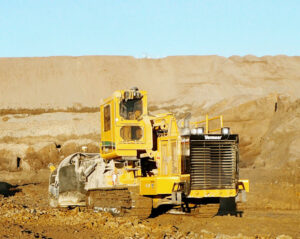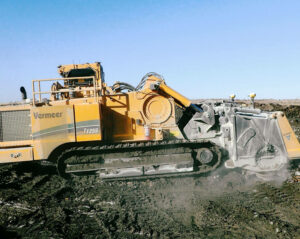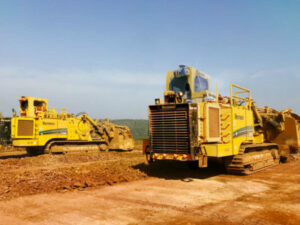No longer a new mining method, the African mining industry is seeing the benefits of employing continuous mining methods. Many mining regions have already adopted this method, and those who have used it have set aside drill and blast almost completely. This is typically due to continuous surface mining’s ability to maximize productivity while minimizing noise, vibrations, dust and security concerns.
HOW CONTINUOUS SURFACING MINING WORKS
Continuous surface mining follows an ore body in three dimensions to help increase ore quality compared to that from drill and blast techniques. This is possible because continuous surface mining keeps the ore separate from the waste. In addition to eliminating the need for a primary crusher, this mining technique allows for the production of uniform material with a tight particle size distribution. Top-down cutting allows variation in product size, with fewer fines being generated than that obtained in the same material using drill and blast techniques.
CONTINUOUS SURFACE MINING OPTIMIZES AFRICAN MINING OPERATIONS
All of this is true, but is continuous surface mining suitable for the African mining industry? Frank Beerthuis is the managing director of Sub-Saharan Africa for Vermeer Equipment Suppliers. Beerthuis has been serving Vermeer and the African mining community since 2008 and has a solid understanding of continuous surface mining in the area. Ruben de Meijer is the managing director for Vermeer West Africa and has been serving the mining community since 2013. They recently shared their experience and thoughts to clarify and promote the use of this methodology.
Continuous surface mining made its way to Beerthuis’ region, headquartered in South Africa, in 2008, while de Meijer’s West Africa territory did not see an operating continuous surface miner until several years later.
Continuous surface mining on a West Africa copper mine
Beerthuis remembered the 2008 introduction clearly. “Freeport McMoran had a majority ownership stake in the copper deposits of Tenke-Fungurumi in the South-Eastern part of the Democratic Republic of Congo,” he said. “Copper deposits generally were thin seams of high-grade ore.” It proved to be a perfect opportunity to introduce the continuous mining method to this African mining operation. The Vermeer Terrain Leveler® surface excavation machine (SEM) provided more than mining efficiency.
Freeport McMoran crews used the Vermeer surface miner to prepare the construction site. First, they leveled the site for the processing plant and the mine’s labor camp. Crews constructed roads and haul-road infrastructure for the open pit mine location. Then, crews used the surface miner to remove overburden from the ore bodies, providing access to the copper seams.
When asked about the results of this experiment, Beerthuis replied, “Once the initial ore processing plant was operational and there was open access to the ore bodies, Vermeer trenchers were used to do a 23.5-in (60-cm) deep sampling of the area. There was a clear visual difference in the color of the ore, so high-grade and lower-grade areas could be mapped. The Tenke mine then used the surface miners to mine the copper ore and selectively load and stockpile the lower grade ore seams. Between 2009 and 2012, the mine invested in a total of five Vermeer T1255III Terrain Leveler® SEMs.”
Continuous surface mining on a South Africa bauxite mine
De Meijer also shared details of his first continuous surface mining customer, SMB-Winning, in Guinea, Africa. Their mine holds some of the world’s highest-quality bauxite deposits. Societe Miniere de Boke (SMB) was formed in 2014 to efficiently extract, process and transport the material from the mine.
The African mining consortium is committed to optimizing all aspects of its operations. In addition to visiting several other mining operations and contractors using surface miners for road construction, SMB invited the team from the Vermeer West Africa dealership for a visit.
While there, the group gathered rock samples to ship back to the Vermeer Rock Lab located within the company’s headquarters in Pella, Iowa. The experts at the Vermeer Rock Lab conducted unconfined compressive strength, indirect tension, abrasivity and energy index testing to help determine how the material would respond when being cut. Based on that information, the local dealer helped SMB estimate production and service expenses associated with using a Vermeer surface miner.
SMB invested in two Vermeer surface miners for the mine and made arrangements to run the machines in conjunction with its drilling and blasting methods. To get a side-by-side comparison, the mine was divided into two areas.
The SMB consortium is impressed with this new way of mining. “Overall, the consortium says using the surface miners is more cost efficient than drilling and blasting,” de Meijer explained. “They are saving on labor expenses and have been able to minimize the number of times material has to be handled.”
After these “early adopters” began using continuous surface mining methods, others in the African mining industry came on board. Beerthuis reported that in sub-Saharan Africa, there are more than a dozen mines and quarries operating surface miners. The majority of these units operate in coal and, to a lesser extent, limestone. In de Meijer’s case, there are currently 10 to 15 mines using surface miners in his territory.
CONTINUOUS SURFACE MINING DELIVERS MEASURABLE RESULTS
The reasons for making the change are straightforward. The mines may no longer need to drill and blast, and subtracting explosives from the equation not only makes the mine more secure but also makes the mine a better neighbor to those living in the surrounding area and lessens environmental impact. In some areas, security concerns related to the transport, storage, usage and administration of explosives make the use of a surface miner even more attractive. Also, there is no need to use or maintain primary crushers at many locations. Both de Meijer and Beerthuis reported that the adoption of continuous surface mining resulted in the complete replacement of the drill and blast method at many mines.
Does the use of continuous surface mining really maximize production? Beerthuis said, “In soft commodities like coal, our machines have achieved instantaneous production rates of up to 2,204.6 tons (2,000 mT) per hour. In certain medium-hard materials and minerals with a high energy index, production rates can be up to 102.3 tons (1,000 mT) per hour depending on conditions.”
De Meijer has seen the same type of result in his area. “Some of our customers are doing around 2.97 million tons to 3.53 million tons (2.7 million mT to 3.2 million mT) per machine per year, using the Vermeer T1255III single-side direct drive model,” he said.
VERMEER CONTINUOUS SURFACE MINERS SET THE STANDARD
Of course, Vermeer is not the only source for surface miners. But the Vermeer surface miner line of machines does stand out. De Meijer said the machines are known for their high mechanical availability. He cited some numbers to back up his assertion.
“Some of our machines have over 35,000 engine hours and still have a mechanical availability of 90%,” he said.
“Customers are sometimes incredulous when we tell them our machines are reaching close to 8,000 engine hours per year — and there are only 8,760 hours in a year.”
Ruben de Meijer
“Of course, customers are also impressed by the machines’ features,” he continued. “Our surface miners can work on slopes and uneven terrain, and they can rotate on the spot 360 degrees, just to name a few.”
But both men said the primary attraction of the Vermeer surface miner line for the African mining industry has been the fact that Vermeer has a positive, global track record in the supply and service of continuous surface mining machines.
“The Vermeer backup support has proven to be second to none, which gives potential new customers peace of mind when making a purchase decision,” said Beerthuis.
De Meijer added, “The expertise of the dealership is an essential ingredient in the total package we offer customers. Due to our experience, we are able to provide our customers with accurate performance data based on measurements in the field. The dealership is able to support the mining company from study phase to operational phase with all the support required to run a mining project successfully.”
THE FUTURE OF CONTINUOUS SURFACE MINING FOR THE AFRICAN MINING INDUSTRY
Of course, the ultimate question is: Do continuous mining methods have a future in Africa’s great mining regions? Neither de Meijer nor Beerthuis had any doubts.
“There will be growing potential as a consequence of increased restrictions imposed on the use of explosives,” said Beerthuis. “Secondarily, global environmental awareness will lead to the use of more sustainable mining methods on the African continent.”
And de Meijer said he believes continuous surface mining is still in its infancy. “In countries like Guinea-Conakry (bauxite) and India (coal), it is the preferred method. In these countries, mining companies insist on using continuous surface mining. Most other mining companies still see it as a new technology, although it has been used all over the world for more than 20 years.”
Beerthuis said his company has recently done a study regarding the possibility of using Vermeer surface miners to mine diamonds embedded in kimberlite deposits. They believe this could minimize diamond losses.
However that experiment works out, one thing is certain. Continuous surface mining is a methodology that is making African mines secure, sustainable and productive.



